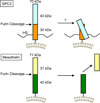Advances in liver cancer antibody therapies: a focus on glypican-3 and mesothelin
- PMID: 21942912
- PMCID: PMC3198870
- DOI: 10.2165/11595360-000000000-00000
Advances in liver cancer antibody therapies: a focus on glypican-3 and mesothelin
Abstract
Liver cancer is one of the most common malignancies worldwide. Hepatocellular carcinoma (HCC) and cholangiocarcinoma (CCA) are the two most common primary liver cancers, yet there have been no significant advances in effective therapeutics. There is an urgent need to identify molecular targets for the development of novel therapeutic approaches. In this review, glypican-3 (GPC3) and mesothelin are discussed, with a focus on their potential as targets for antibody therapy in liver cancer. GPC3 and mesothelin are glycosylphosphatidylinositol-anchored proteins present on the cell surface. They are attractive candidates for liver cancer therapy given that GPC3 and mesothelin show high expression in HCC and CCA, respectively. Antibody drugs targeting GPC3 or mesothelin have shown anti-cancer activity in mice. Humanized or chimeric IgG molecules based on first-generation murine monoclonal antibodies against these antigens are being evaluated in clinical studies. Recently, fully human monoclonal antibodies against GPC3 and mesothelin have been isolated by antibody phage display technology that may provide opportunities for novel cancer therapy.
Conflict of interest statement
The author has no conflict of interest directly relevant to the content of this review.
Figures

References
Publication types
MeSH terms
Substances
Grants and funding
LinkOut - more resources
Full Text Sources
Other Literature Sources
Medical

